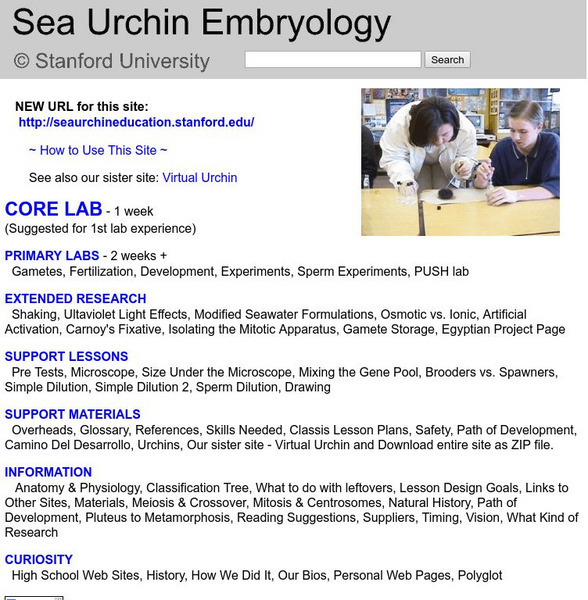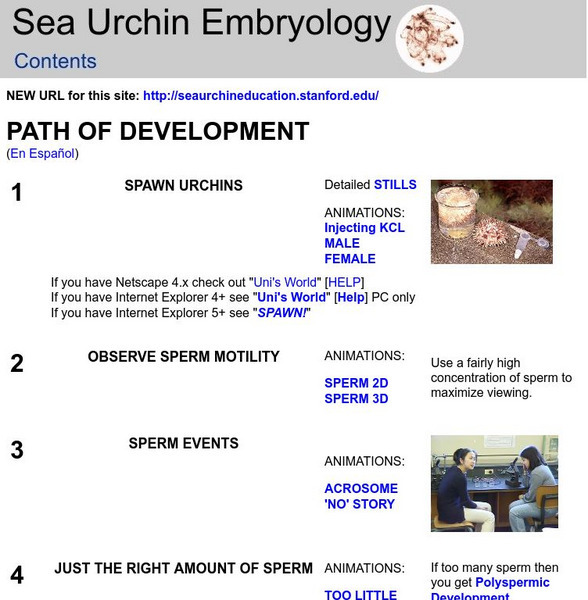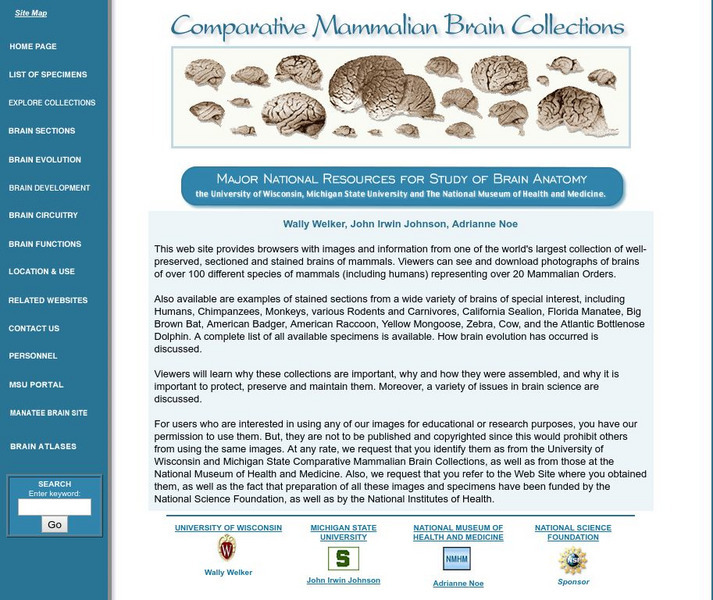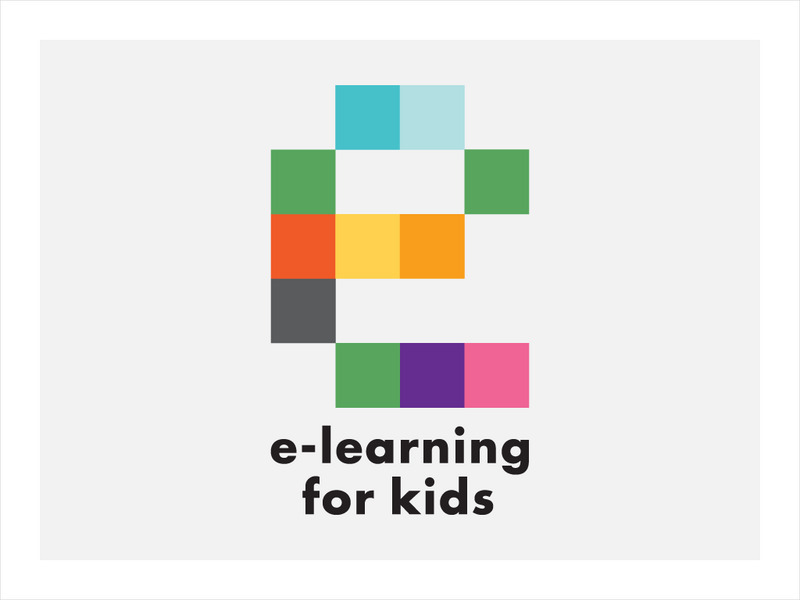Lawrence Berkeley National Laboratory
Berkeley Lab: Virtual Frog Builder
As a great follow-up activity to a frog dissection, students build a virtual frog in this interactive game. It tests learners' knowledge of the three-dimensional spatial relationships of the frog organs.
PBS
Pbs Learning Media: Molecular Clocks: Proteins That Evolve at Different Rates
In this graphic and article from "The Human Evolution Coloring Book" by Adrienne Zihlman, four different proteins from humans and horses are compared and the reasons each protein evolves at its own characteristic rate are discussed.
Stanford University
Stanford University: Sea Urchin Embryology
A fantastic set of lab exercises, background information, teaching materials and references. Great for high school biology.
Stanford University
Stanford University: Sea Urchin Development: Core Lab Exercise
See sea urchins as they develop. A complete set of instructions for a lab in developmental biology. Excellent supporting material is provided, including troubleshooting information.
Stanford University
Stanford University: Primary Labs
This set of exercises provides well written procedures and background for labs at basic and advanced levels.
Stanford University
Stanford University: Path of Development (Animal Developmental Pathways)
An exciting explanation of animal development using sea urchins as a model. Animations, still images and supporting explanations make for a great learning experience.
Smithsonian Institution
Smithsonian Learning Lab: A Mouse Like a House? A Pocket Elephant?
Teachers can download this teaching package that discusses the limits on animal size, both big and small, and what effect size has on animals. Students will enjoy the hands-on activities described in the lessons. Teachers will appreciate...
Other
National Museum of Health and Medicine: Comparative Mammalian Brain Collections
This resource could be used for higher level biology or anatomy classes. There are over 100 different species of mammals represented and each has information about physical characteristics, distribution, and pictures of the brain. There...
Other
Simple Science: Hand It to the Animals
The innovative resource has students examine X-ray images of the ?hands? of different animals and then determine the function of each hand from its form. The activity has an interactive online version and a printable data sheet.
PBS
Pbs: Dissection101: Dissection Resources for Classroom Use
A collection of lesson plans, quizzes, and educational videos developed for online dissections. The site hopes to improve the learning experience for students, and increase the quality of the dissection experience. Organisms included are...
PBS
Pbs Learning Media: Dissection 101: Dogfish Shark Dissection: Lesson Plan
A lesson plan on how to complete a dogfish shark dissection with a class. Lesson plan includes a procedure, PowerPoint, and quiz.
E-learning for Kids
E Learning for Kids: Science: Bermuda Triangle: How Are Animals and Humans Similar to and Different From One Another?
Paula has landed on an unknown island. She learns a lot about all the different animals on this island. Join her and learn with her.
E-learning for Kids
E Learning for Kids: Science: Center of the Atlantic Ocean: Animals and Their Senses
Captain Ed Smith and his dog, Rocco, are exploring all the amazing senses animals have. Join him and discover with them.
McGraw Hill
Glencoe Biology: Animal Body Plans: Self Check Quiz
Try these five multiple-choice questions about animal body plans. After submitting answers, students can review the material.
eSkeletons
E Skeletons: Boneviewer: Mouse Lemur
Identify the parts of the skull belonging to a Mouse Lemur.
eSkeletons
E Skeletons: Skeletons
This website provides an interactive environment in which to examine and learn about skeletal anatomy through an osteology database.
A-Z Animals
A Z Animals: Reference: Anatomy
This entry identifies the defining characteristics animal anatomy.
TED Talks
Ted: Ted Ed: A Simple Way to Tell Insects Apart
Anika Hazra explains how the features of an insect's mouthparts can help identify which order it belongs to, while also providing clues about how it evolved and what it feeds on.
TED Talks
Ted: Ted Ed: Why Do Dogs Have Floppy Ears?
Have you ever wondered why some dogs have floppy ears, but wolves don't? This video by NPR's Skunk Bear illustrates the evolutionary process that may explain why certain domesticated animals look and act differently than their untamed...
Utah Education Network
Uen: Animal Coverings
In this lesson, students sort animal pictures by their body coverings. They learn about the functions of animal coverings and where the different categories might live.
CK-12 Foundation
Ck 12: Plix Series: Comparative Anatomy: Comparative Embryology
[Free Registration/Login Required] Match the animals with their embryos and answer questions about their evolutionary ancestry.
CK-12 Foundation
Ck 12: Biology: Living Species
[Free Registration/Login may be required to access all resource tools.] Discusses how evidence from living species provides clues about evolution.
CK-12 Foundation
Ck 12: Third Grade Science: Life Sci: Animal Characteristics and Classification
[Free Registration/Login may be required to access all resource tools.] Presents an overview of the major animals groups (mammals, birds, reptiles, amphibians, fish, arthropods, vertebrates, invertebrates, those having live births and...
Biology 4 kids
Biology4 Kids: Quiz: Animal Systems
Take this ten-question review quiz over animal systems. Read more about each question after an incorrect answer is given.


















